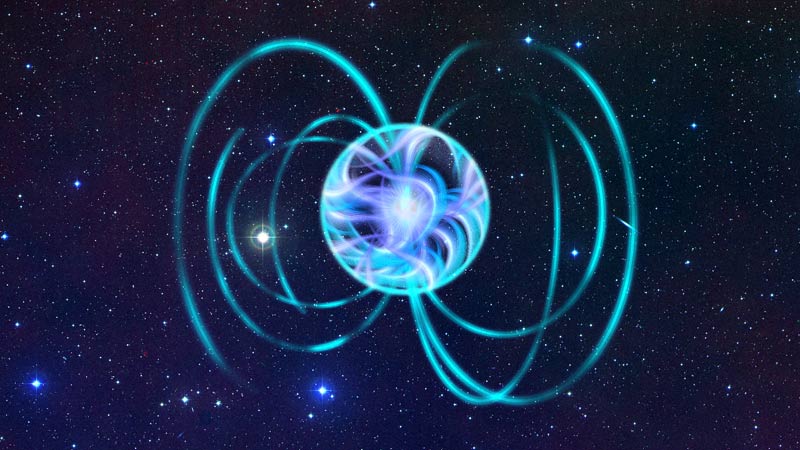Discovery Puts New Spin on Universe's Most Powerful Magnets

Strange fast-spinning stars called magnetars get their namesfrom the fact that they are the universe's most powerful magnets and unleashmassive amounts of radiation. But now scientists have found that some magnetarscan release mighty explosions without needing giant magnetic fields as previouslythought.
Magnetars are a kind of pulsingneutron star (or pulsar) ? a remnant of a star left over after a supernova,when a star's explosion crushed protons together with electrons into neutrons. Theyare a thousand times more magnetic than an ordinary neutron star and 10trillion times more so than a refrigerator magnet.
Neutron stars are some of the densest objects known. Althoughthey are usually only about 12 miles (20 km) across, they are often 1.5 to 3times the mass of the sun. A piece of a neutronstar the size of a sugar cube can weigh about 100 million tons, or roughlyas much as a mountain.
Now researchers have discovered a magnetic neutron star thatmay rewrite the book on magnetars? SGR 0418+5729, roughly 7,000 light-years from Earth.
Measuring a magnetic star
Astrophysicist Nanda Rea at the Institute of Space Sciencesin Barcelona, Spain, and her colleagues measured how fast SGR 0418+5729 wasspinning using data from four different X-ray space observatories.
The more powerful the magnetic field of a neutron star is,the more it tends to slow down the speedof thestar's spin. As such, measuring this slowdown allows researchers toestimate the intensity of the neutron stars' surface magnetic fields.
Get the Space.com Newsletter
Breaking space news, the latest updates on rocket launches, skywatching events and more!
Typical magnetars have magnetic fields measuring up to amillion billion gauss in strength ? strong enough to rip atoms apart. Only 16or so magnetars are known to date.
But the researchers said their magnetar appeared to have amagnetic field that is roughly as small as those typically seen with ordinaryneutron stars. [TheStrangest Things In Space]
This suggests a lot of regular neutron stars "mightstart behaving as magnetars at anytime, regardless of their low magneticfields," Rea told SPACE.com.
Magnetar's hidden power?
Magnetars are believed to include stars known as soft gammarepeaters (like SGR 0418+5729) and anomalous X-ray pulsars, which are known forexplosions of gamma rays and X-rays that can last from days to years.Scientists had thought the magnetars' powerful magnetic fields were the drivingforce behind these extraordinary bursts.
The researchers suggest the source of their magnetar's powermight be hidden deep within its surface. Although its surface magnetic fieldmight not be as strong as typically seen in magnetars, it could still have ahuge internal magnetic field.
"It is the very first time this has been observed and the discoveryposes the question of where the powering mechanism is in this case," studyco-author Silvia Zane, of the University College London, said in a statement."At this point, we are also interested in how many of the other normal,low field neutron stars that populate the galaxy can at some point wake up andmanifest themselves as a flaring source."
SGR 0418+5729 is 24 million years old, making it quite olderthan other soft gamma repeaters and anomalous X-ray pulsars.
"We might be seeing an old population of magnetar whichare dissipating in bursts its last bit of its internal magnetic energy,"Rea said.
The research is detailed in the Oct. 15 issue of the journalScience.
- The Strangest Things In Space
- Top 10 Star Mysteries
- Massive Mega-Star Challenges BlackHole Theories
Join our Space Forums to keep talking space on the latest missions, night sky and more! And if you have a news tip, correction or comment, let us know at: community@space.com.

Charles Q. Choi is a contributing writer for Space.com and Live Science. He covers all things human origins and astronomy as well as physics, animals and general science topics. Charles has a Master of Arts degree from the University of Missouri-Columbia, School of Journalism and a Bachelor of Arts degree from the University of South Florida. Charles has visited every continent on Earth, drinking rancid yak butter tea in Lhasa, snorkeling with sea lions in the Galapagos and even climbing an iceberg in Antarctica. Visit him at http://www.sciwriter.us









